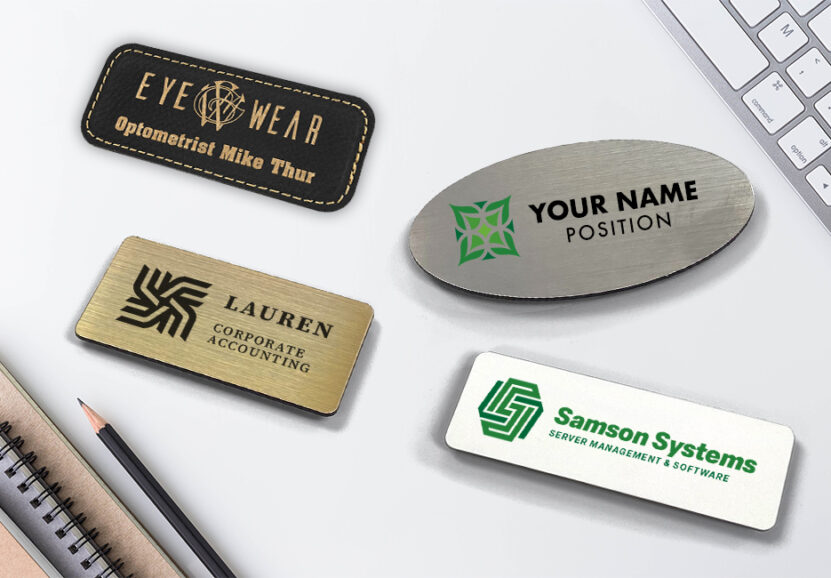In any professional setting, name tags, though seemingly inconspicuous, play an integral role in shaping interactions and first impressions. These tiny pieces of identification not only bridge the initial chasm of unfamiliarity but also set the tone for forthcoming professional dynamics. The significance of name tags transcends their primary utility; they act as facilitators for smoother customer engagements, bolster team dynamics, and engender an atmosphere of mutual respect and openness. As we embark on this journey, we will deep dive into the myriad nuances and best practices of tag etiquette that are indispensable in today’s business milieu.
The Purpose of Name Tags

The contemporary business environment underscores the importance of seamless communication and quick introductions. Name tags emerge as the unsung heroes in this narrative. Their primary purpose, of course, is to identify. However, in the world of business, this identification plays a pivotal role in fostering instant rapport and ensuring effective networking. Imagine walking into a conference room, instantly recognizing a person’s designation and expertise just by glancing at their tag – the ease of initiating a conversation becomes significantly enhanced. Moreover, name tags instill a sense of pride and belonging among employees, representing their association with the brand or company. A well-designed tag doesn’t just end at stating the person’s name; it’s a testament to the company’s commitment to professionalism and detail. Additionally, for customers and new members, tags become a welcoming beacon, assuring them of approachable staff and a friendly environment.
Choosing the Right Name Tags
Selecting an appropriate name tag is not as straightforward as it might seem. Various factors come into play, from the design to its method of attachment. Magnetic tags, for instance, are lauded for not damaging clothing and are a preferred choice in many formal settings. However, there are also pin-on designs that are economical and practical, and lanyard types which are often favored for events and conferences for their visibility. But beyond the type, businesses need to be mindful of the design. Does it reflect the company’s branding? Is it durable enough for everyday use? For instance, a high-end luxury brand might opt for a sleek, metallic design, whereas an NGO might choose eco-friendly materials to resonate with their ethos. It’s pivotal to ensure that name tags, albeit small, align with the brand’s identity and the context in which they’ll be used.
Design and Layout

The design and layout of a name tag carry the dual responsibility of being aesthetically pleasing and functionally efficient. A cluttered tag can impede communication, while one that’s too sparse may lack necessary details. The placement of names, titles, and company logos must be intuitive. Typically, the person’s name should hold prime real estate on the tag, given its primary function. Titles, though secondary, should still be clearly visible, aiding in understanding the individual’s role. Logos or branding elements can be incorporated either at the top or the side, ensuring that they don’t overshadow the name but still offer brand recognition. The tag’s layout should aim for a balance – an equilibrium of form and function where each element complements the other.
Font and Text Size
As trivial as it might sound, font choices can make or break the effectiveness of a name tag. Opting for ornate, cursive fonts may align with a brand’s aesthetic, but it could compromise legibility. The ideal choice is a clean, sans-serif font that can be easily read from a reasonable distance. Text size, too, is a balancing act. It should be large enough for someone to read without straining their eyes but not so large that it appears garish or overwhelming. As a rule of thumb, names should be in the largest font size, followed by titles, and then any secondary information. Above all, the guiding principle should be clarity.
Employee Name Tags

In customer-centric environments, employee name tags transcend their identification role, becoming tools that enhance service quality. They eliminate the guesswork for customers, providing clear cues for addressing staff. By including specific details like names, titles, and departments, customers can quickly identify whom to approach for specific needs. Moreover, consistency is key. Ensuring that every employee, from senior management to frontline staff, wears their tags fosters an egalitarian work culture and reinforces the importance of every role.
Guest and Visitor Tags
Providing name tags for guests or visitors might seem like a simple courtesy, but it’s an essential aspect of fostering inclusivity. Whether it’s a workshop, corporate event, or an office visit, guest tags instill a sense of belonging. They also play a practical role in security and ensuring that guests can be easily identified by staff. Personalizing these name tags, especially for specific events, can elevate the guest’s experience, making them feel valued and recognized.
Name Tag Etiquette for Employees
How and where an employee wears their name tag is as important as the information it holds. Guidelines should be established for correct placement, typically on the right side near the shoulder, making it easier for people to glance at when shaking hands. The tag should be parallel to the ground, avoiding any awkward tilting. Employees should also be trained to maintain their name tags, ensuring they’re free of smudges or wear and tear, reflecting professionalism and attention to detail.
Networking Events and Conferences

At networking events and conferences, where first impressions are vital, name tags serve as silent introductions. Beyond just names and titles, these tags can incorporate fun icebreakers or QR codes linking to professional profiles. The key here is creativity – how can a tag be both informative and a conversation starter? An innovative approach can transform name tags from mere identification tools to powerful networking assets.
Tag Etiquette for Customers
While name tags primarily serve employees, they also have indirect benefits for customers. Recognizing employees by their first names can foster a sense of familiarity and trust. Tags act as subtle invitations for customers to engage in more personalized, human-to-human interactions, thereby enhancing the overall customer experience.
Handling Tag Mistakes
Inevitably, there will be moments of oversight – misspelled names, incorrect titles, or misplaced badges. Such mishaps, while seemingly minor, can affect an individual’s confidence and comfort. It’s crucial to address these promptly, ensuring replacements are provided swiftly. Proactive measures, like double-checking details before printing or allowing employees to review and approve their tag details, can mitigate such errors.

